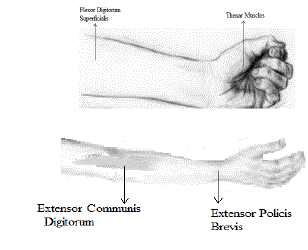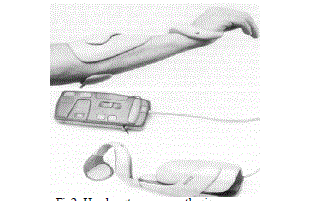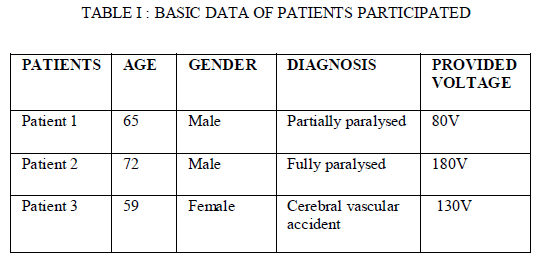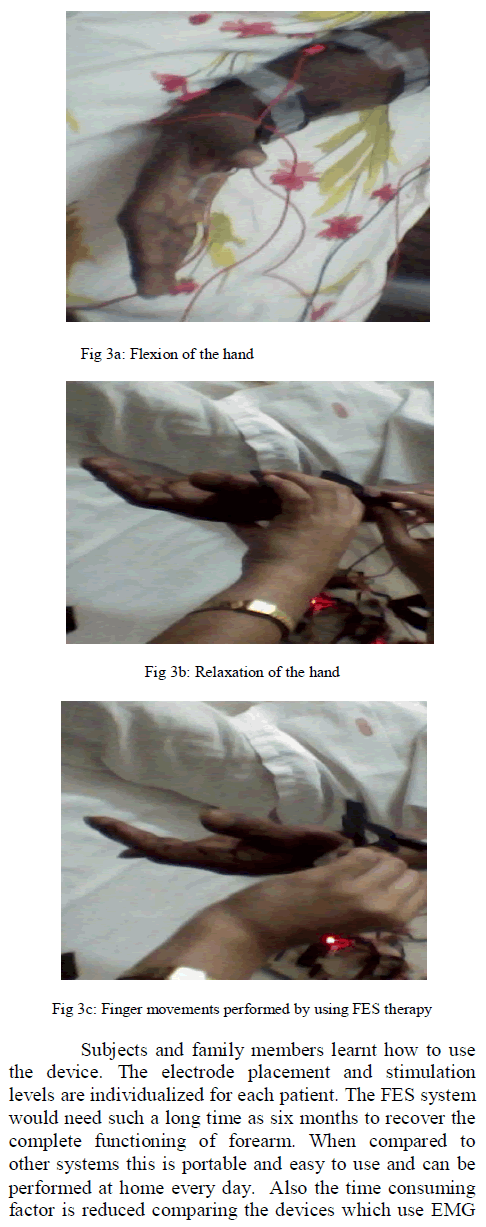ISSN ONLINE(2319-8753)PRINT(2347-6710)
ISSN ONLINE(2319-8753)PRINT(2347-6710)
S. Maheswari1, A. Anusuya2, P. Preveena2, R. Sangeetha2
|
| Related article at Pubmed, Scholar Google |
Visit for more related articles at International Journal of Innovative Research in Science, Engineering and Technology
Functional electrical stimulation (FES) is an effective technique for the hand rehabilitation functions such as grasping and releasing. The paralysed patients cannot carry out the activities of daily living. This system can be used for the stroke and spinal cord injured individuals. The technology used in the restoration of hand functions are generally used for the neuro prosthetic restoration. Several prospective studies have shown that repeated motor practice and the motor activity in the real world environment have a favourable effect on the motor recovery in stroke patients. Functional Electrical Stimulation induces greater muscle contraction by providing stimulus through the electrode. By applying stimulus through the electrode, the grasping and the releasing actions has been achieved. The level of stimulation for the paralysed hand can be adjusted by using the control knob. This stimulation adjustment makes the patient to feel comfort.
Keywords |
| Functional Electrical Stimulation, Neuro prostheses, Stroke, Hand paralysis. |
INTRODUCTION |
| Functional electrical stimulation has been applied to provide control for the movements or the functions by generating electrical stimuli to the nerves or muscles. It is also helpful to restore the lost functions of the hemiplegic patients. The daily activities of the patients are also impaired. The most common cause of hemiplegia is stroke. Strokes can cause a variety of movement disorders, depending on the location and the severity of the lesion. Hemiplegia is common when the stroke affects the corticospinal tract. Other causes of hemiplegia include spinal cord injury, specifically Brown-Sequard syndrome, traumatic brain injury, or diseases affecting brain[8]. As a lesion that results in hemiplegia occurs in the brain or spinal cord, hemiplegic muscles display features of the Upper Motor Neuron Syndrome. Physical therapy can improve muscle strength and coordination, mobility and other physical functions using the different sensorimotor techniques. Rehabilitation is the main treatment of the individuals with hemiplegia. In all cases, the major aim of rehabilitation is to regain maximum function and quality of life. The exact cause of hemiplegia is not known in all cases, but it appears that the brain is deprived of oxygen and this result in the death of neurons. When the corticospinal tract is damaged, the injury is usually manifested in the opposite side of the body. For example if one has an injury on the right side of the brain, the hemiplegia will be on the left side of the body[6]. This happens because the motor fibres of corticospinal tract, which take origin from the motor cortex in brain, cross to the opposite side in the lower part of medulla oblongata and then descend down in spinal cord to supply their respective muscles[7]. Depending on the site of lesion in brain, the severity of the hemiplegia varies. A lesion in internal capsule where all the motor fibres are condensed in a small area, will cause dense hemiplegia i.e. complete loss of power of all muscles of one half of the body. |
MATERIALS AND METHODS |
| Our main aim was to implement the grasp and release patterns and also to find a practical way for their reproducible generation. One major request was to use surface electrodes placed only on the forearm eliminating the need for electrodes on or inside the hand. First, the lateral grasp pattern providing the ability of picking up flat objects between the flexed fingers and the flexing thumbs has been achieved by stimulation of finger(M.ext. digitorum communis) and thumb (M.ext. pollics longus) extensor muscle for hand opening, the fingerflexors (M.flex.digitorum superficialis, M.flex.digitorum profundus) for hand closing and the thumb flexor(M.flex. pollicis longus) for grasping[5]. |
 |
| Fig1: Muscle motor points identification |
| By using a dedicated stimulation profile it has been possible to use a contraction of the thumb flexor and the extensor muscles to achieve a state, in which the fingers are sufficiently flexed and the thumb is still in an extended position. This stimulation profile has been iteratively determined during an initial screen session as shown in fig1. Second, for the palmar grasp a branch of the median nerve innervating the M.opponents has been selectively stimulated with an electrode placed on the forearm[4]. After the electrode positions have been defined during the initial setup session. The Velcro strips hold the electrodes in s fixed position. Due to the voluntary wrist extension and a denervation of the wrist extensor muscle in our end user, it was not possible to achieve a stable dorsal extension of the wrist by stimulation. |
EXISTING SYSTEMS |
| A. FES therapy for spasticity in stroke patients with upper extremities |
| The functional rehabilitation uses an EMGcontrolled stimulator with a pair of surface electrodes records both EMG & delivers electrical stimulation[1]. The main drawback of EMG-triggered neuromuscular electrical stimulation system cannot control electrical stimulation in proportion to voluntary EMG after onset of preprogrammed electrical stimulation. |
| Currently, FES systems are used to improve the functionality for disability patients. The feasibility of using accelerometer controlled electrical stimulation for the elbow, wrist and finger extensors which enables functional task practice in patients with chronic hemiparesis but the accelerometer is controlling electrical stimulation in which the trigger for stimulation is directly associated with forward reach and grasp as shown in fig2. |
| B. Neuroprosthesis for Grasping |
| The neuroprosthesis applies FES to artificially generate muscle contractions to perform reaching & grasping tasks in subjects who lost voluntary control of these muscles due to disease or injury[2]. It uses bursts of short electric pulses of pulse width 0-250 microseconds and pulse amplitude 10-150mA to generate muscle contraction by stimulating motor neurons or reflex pathways. |
 |
| Fig2: Handmaster neuroprothesis |
| 1) Use of an implanted FES system: These devices should only be applied once the patient reached stable neurological status & no further improvements of function are expected. It usually applied to SCI subjects two or more years after trauma. |
| 2) Use of surface FES system: This system introduces FES training during early rehabilitation period because the technology does not require from subject to be neurologically stable. |
| C. Artificial grasping for the paralyzed hand |
| Here 8 channel microcomputer controlled stimulator with monophasic square voltage output was used and muscle activation sequences were power grip(index finger extension type). The electrical stimulation has the potential for exciting every muscle with intact peripheral enervation[3]. |
| The main drawback is maximum pulse width was fixed at 300 microseconds & frequency at 20 hertz then amplitude was adjusted to achieve excitability threshold for each muscle. The possibility to obtain a functional grasp despite an open loop fixed stimulation parameter system and surface electrodes. Fine movements of hand could be performed by voluntary movements of shoulder & elbow allowing objects to write & training can improve pen control and writing speed. |
PROPOSED SYSTEM |
| second & this will elicit action potentials in the motor nerve. Controller is programmed to generate square pulse width 250microseconds and frequency. Of 40hertz and amplitude is individually adjusted to achieve threshold for flexion & extension. |
| Stimulation pulses are applied through the skin to the nerves via electrodes. The main advantage of using silicon rubber electrode are high thermal conduction and electrical stimulation and also reduce chronic & acute pain from various causes. |
| Stimulation pulses are applied through the skin to the nerves via electrodes. |
| For flexion-Range of 0 to 180V |
| For extension-Range 0 to 180V |
| The voltage input to L-Driver is varied with variable supply circuit. |
RESULTS AND DISCUSSION |
| The study was now carried out with two patients who had different residual capabilities. The first patient is a 70 years old man who has suffered hemorrhagic stroke 6 months before and he did not have any sense in the paretic arm. The second patient is 57 years old man who had stroke 2 years earlier but in this case he is now using his forearm for limited activities but the residual capacity is not completely recovered. The user can start the two channels individually or simultaneously. The maximum voluntary contraction levels of forearm showed good variations.tha arm spasticity and muscle tone were also seemed to improve on the basis of regular usage. From the present results we could suggest that intensive FES therapy would improve the forearm functions which is attributed to the enhancement of coordinated muscle activity and improved muscle tone. The figure 3a, 3b and 3c shows the flexion and the relaxation of the hand and also the finger movements performed by using this functional electrical stimulation. By using this therapy continuously, the patient can able to perform the functions without using this stimulation. |
 |
 ' ' |
| sensing modules. Daily usage at home can change the physical status and functional abilities for the patients who were receiving long term treatments. At last reporting that continuous usage would be needed to achieve fine grip movements in hemiplegic patients. |
CONCLUSION |
| In this study, the patient with hemiplegia used their residual capabilities to restore the hand functions by adjusting the control knob for providing the appropriate stimulus. The subjects can successfully operate the FES system by surface electrical stimulation. We can further improve the system by designing forearm orthotics or positioning sensors. |
References |
|